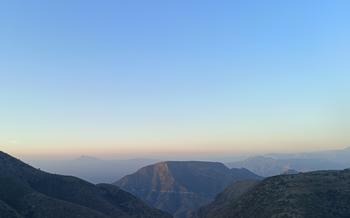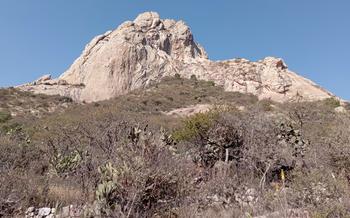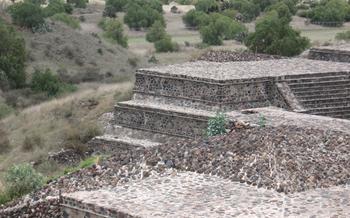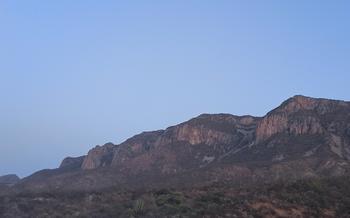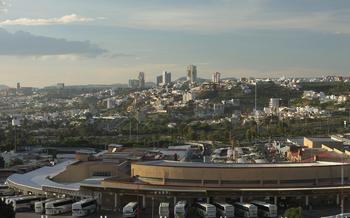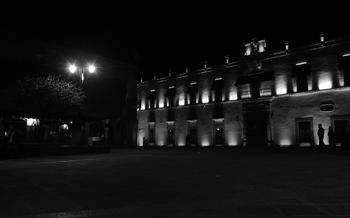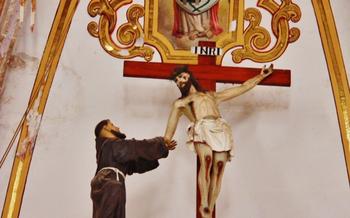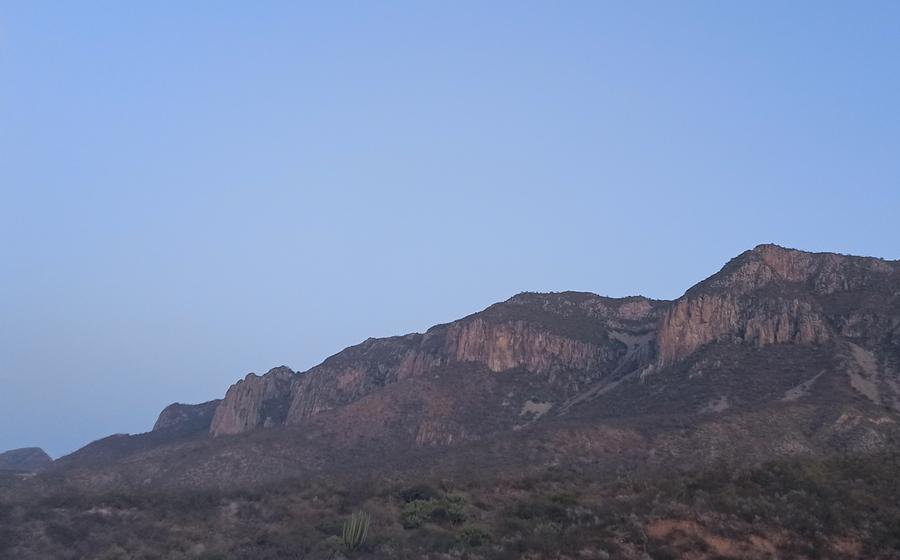
Sierra Gorda Biosphere Reserve
- Sierra Gorda Biosphere Reserve: A Natural Paradise
- Explore the Mesas and Canyons
- Discover the Hidden Waterfalls
- Spot the Endemic Wildlife
- Visit the Indigenous Communities
- Hike the Scenic Trails
- Camp Under the Stars
- Take a Refreshing Dip in the Natural Pools
- Witness the Monarch Butterfly Migration
- Visit the Missions and Churches
- Indulge in Local Cuisine
- Experience the Local Festivals
- Learn About the Local History and Culture
- Insider Tip: Off-the-Beaten-Path Gems
Sierra Gorda Biosphere Reserve: A Natural Paradise
In the heart of Mexico, nestled amidst the rugged peaks of the Sierra Madre Oriental, lies the breathtaking Sierra Gorda Biosphere Reserve, a UNESCO World Heritage Site. This vast expanse of protected wilderness encompasses over 383,000 hectares of pristine ecosystems, including cloud forests, tropical dry forests, and oak woodlands. The reserve is home to an astonishing array of biodiversity, with over 3,000 species of plants and animals, including many endemic and endangered species.
The Sierra Gorda's unique geological formations, including towering mesas and deep canyons, have earned it recognition as a UNESCO World Heritage Site. These geological wonders, shaped over millions of years by the forces of wind and water, offer breathtaking vistas and a glimpse into the Earth's ancient past.
Getting to the Sierra Gorda Biosphere Reserve is relatively easy, with several access points from nearby cities such as Queretaro and San Luis Potosi. Visitors can choose from various accommodation options, ranging from rustic campsites to comfortable eco-lodges, allowing them to immerse themselves in the natural beauty of the reserve.
Explore the Mesas and Canyons
The Sierra Gorda Biosphere Reserve is home to a stunning array of mesas and canyons, formed over millions of years by the erosive forces of wind and water. These geological wonders are not only visually captivating but also offer a glimpse into the region's rich geological history.
Among the most impressive mesas is El Picacho, a towering monolith that rises over 2,000 meters above sea level. Its sheer cliffs and jagged peaks provide a thrilling challenge for experienced climbers and breathtaking views for those who prefer to admire it from afar. La Sombrerera, another notable mesa, is renowned for its distinctive mushroom-shaped formation, a result of differential erosion.
The reserve's canyons are equally awe-inspiring. El Sótano del Barro is one of the deepest and most spectacular, with sheer walls plunging over 400 meters into a verdant abyss. The canyon is home to a diverse array of plant and animal life, including endemic species found nowhere else in the world.
To fully appreciate the grandeur of these mesas and canyons, visitors can embark on a variety of hiking trails that wind through the rugged terrain. These trails offer varying levels of difficulty, from beginner-friendly paths to challenging treks for seasoned hikers.
Along the way, hikers can marvel at the intricate rock formations, spot wildlife, and soak in the tranquility of the natural surroundings. However, it's important to be prepared for the challenges of hiking in this rugged terrain, including steep inclines, loose rocks, and unpredictable weather conditions. But for those who embrace the adventure, the rewards are immense—unforgettable views, a sense of accomplishment, and a deeper connection with the wonders of nature.
Discover the Hidden Waterfalls
The Sierra Gorda Biosphere Reserve is home to a plethora of enchanting waterfalls, each boasting its own unique charm and allure. Among the most captivating is the Cascada de El Chorro, situated in the heart of the reserve. This majestic waterfall plunges from a height of 40 meters into a crystal-clear pool, surrounded by lush vegetation and towering cliffs. The thunderous roar of the cascading water creates a symphony of sound that reverberates through the canyon, adding to the awe-inspiring spectacle.
Another must-see waterfall is the Cascada de La Golondrina, renowned for its breathtaking beauty and refreshing plunge pools. Hidden within a secluded canyon, this waterfall cascades gracefully into a series of natural pools, inviting visitors to take a refreshing dip in the cool, crystal-clear waters. The surrounding rock formations and lush greenery create a picturesque backdrop, making it an ideal spot for relaxation and contemplation.
Reaching these hidden waterfalls requires varying levels of effort and adventure. Some, like the Cascada de El Chorro, are easily accessible via well-maintained trails, suitable for hikers of all levels. Others, such as the Cascada de La Golondrina, demand a more challenging trek through rugged terrain, rewarding intrepid adventurers with a sense of accomplishment and seclusion.
When exploring these waterfalls, safety should always be a top priority. The paths leading to the falls can be slippery and uneven, requiring sturdy footwear and careful footwork. Swimming in the waterfall pools is generally permitted, but visitors should exercise caution and avoid areas with strong currents or deep water. It's essential to respect the natural environment and leave no trace, ensuring that future generations can enjoy these pristine waterfalls in their unspoiled beauty.
Spot the Endemic Wildlife
The Sierra Gorda Biosphere Reserve is home to a diverse array of endemic wildlife, including various species of birds, mammals, reptiles, and amphibians. Among the most notable endemic species are the Sierra Madre sparrow, a small bird found exclusively in the reserve's cloud forests, and the Queretaro rock squirrel, a playful rodent that inhabits the reserve's rocky outcrops. Visitors can also spot the Sierra Gorda rattlesnake, a venomous snake found only in the reserve's canyons, and the Queretaro tree frog, a brightly colored frog that lives in the reserve's humid forests. These endemic species play a crucial role in maintaining the ecological balance of the reserve, contributing to its rich biodiversity.
To protect these unique species, the reserve has implemented several conservation efforts, including habitat restoration projects, anti-poaching patrols, and educational programs for local communities. By raising awareness and promoting responsible tourism, the reserve aims to ensure the survival of its endemic wildlife for generations to come.
Visit the Indigenous Communities
Within the Sierra Gorda Biosphere Reserve, visitors have the opportunity to connect with the indigenous communities that call this region home. These communities, such as the Otomí, Nahua, and Pame, have preserved their unique traditions, beliefs, and way of life for generations.
Paying a respectful visit to their villages, tourists can witness their vibrant culture firsthand. Visitors can learn about their traditional crafts, including intricate embroidery, pottery, and weaving. These crafts not only showcase their artistic skills but also help sustain their local economy. Supporting local artisans by purchasing their crafts is a meaningful way to contribute to the preservation of their traditions.
To ensure a respectful and enriching interaction, visitors should approach these communities with humility and curiosity. Learning a few phrases in their native languages, such as "hello" and "thank you," can go a long way in showing respect and establishing a connection. Visitors should also be mindful of local customs and traditions, such as asking permission before taking photographs or entering sacred spaces.
By engaging with the indigenous communities, visitors gain a deeper understanding of the rich cultural heritage of the Sierra Gorda Biosphere Reserve. These interactions foster mutual respect and appreciation, creating a lasting bond between visitors and the local people.
Hike the Scenic Trails
The Sierra Gorda Biosphere Reserve offers a diverse network of hiking trails that cater to hikers of all levels, from leisurely strolls to challenging climbs. Whether you're a seasoned adventurer or a nature enthusiast seeking a moderate trek, the reserve has something for everyone.
Popular Trails for Every Level:
-
Sierras Queretanas Trail: Embark on a breathtaking 5-day backpacking journey through the heart of the reserve, traversing remote canyons, lush forests, and indigenous communities. This challenging trail rewards hikers with awe-inspiring views and a deep immersion into the region's natural and cultural heritage.
-
Pinal de Amoles Trail: Experience a moderate 3-day hike that takes you through picturesque landscapes, passing by cascading waterfalls, ancient rock formations, and quaint villages. This trail offers a perfect balance of physical exertion and scenic rewards, making it suitable for hikers of varying abilities.
-
El Chuveje Trail: For a leisurely day hike, explore the El Chuveje Trail, which leads you to a hidden waterfall nestled amidst lush vegetation. The trail is relatively easy, making it ideal for beginners and families with young children, while still offering a refreshing escape into nature.
Highlights and Unique Features:
Each trail in the Sierra Gorda Biosphere Reserve boasts its own unique highlights:
-
Witness the Majestic Cañón del Infiernillo: Hike through the awe-inspiring Cañón del Infiernillo, a deep and rugged canyon that offers breathtaking vistas and a thrilling challenge for experienced hikers.
-
Discover the Hidden Waterfalls of El Chuveje: Take a refreshing dip in the pristine waters of El Chuveje waterfall, a hidden gem tucked away in the lush forests, perfect for escaping the summer heat.
-
Explore the Enchanting Cave of El Aguacate: Embark on a subterranean adventure in the Cueva del Aguacate, a vast and intricate cave system that reveals stunning rock formations and a glimpse into the region's geological history.
Essential Gear and Safety Precautions:
Before embarking on your hiking adventure, ensure you're well-prepared with the necessary gear:
-
Sturdy Hiking Boots: Protect your feet with durable and comfortable hiking boots that provide good ankle support for uneven terrain.
-
Navigation Tools: Bring a map and compass or a reliable GPS device to help you stay on track and avoid getting lost in the wilderness.
-
First-Aid Kit: Pack a comprehensive first-aid kit to address any minor injuries or medical emergencies that may arise during your hike.
-
Sun Protection: Shield yourself from the sun's harmful rays with sunscreen, sunglasses, and a wide-brimmed hat.
-
Hydration: Stay hydrated by carrying sufficient water or a water purification system, especially during hot and dry weather.
Remember, hiking in the Sierra Gorda Biosphere Reserve requires a certain level of physical fitness and preparedness. Always inform someone about your hiking plans and expected return time, and be prepared for changing weather conditions and unexpected challenges.
Camp Under the Stars
Amidst the vast wilderness of the Sierra Gorda Biosphere Reserve, camping enthusiasts can indulge in a truly immersive experience under the starry sky. Designated camping areas are available throughout the reserve, offering a range of options to suit different preferences.
These campsites provide basic facilities such as restrooms, picnic tables, and fire pits, allowing campers to connect with nature without sacrificing comfort. Whether you prefer to pitch a tent or park your RV, there's a spot for every camper.
To ensure a safe and enjoyable camping trip, it's essential to follow the rules and regulations of the reserve. Campfires must be contained within designated fire rings, and visitors should practice responsible waste disposal. Choosing a campsite that aligns with your desired level of privacy and proximity to hiking trails or water sources is also recommended.
For an unforgettable camping experience, consider venturing into the reserve's backcountry, where you'll find secluded campsites that offer unparalleled tranquility and a true sense of wilderness. Remember to pack all necessary supplies, including food, water, and appropriate gear for the weather conditions.
As you settle into your campsite, take a moment to appreciate the stunning night sky. Away from the city lights, the stars shine with exceptional brilliance, creating a breathtaking celestial display. Embrace the serenity of the wilderness, listen to the sounds of nature, and let the beauty of the Sierra Gorda captivate you.
Take a Refreshing Dip in the Natural Pools
Amidst the rugged landscapes of the Sierra Gorda Biosphere Reserve, nature has carved out a series of enchanting natural pools, inviting visitors to immerse themselves in the cool, crystal-clear waters. These pools, formed by cascading rivers and underground springs, offer a refreshing respite from the warm Mexican sun and a chance to connect with the pristine beauty of the reserve.
One of the most popular natural pools is El Chuveje, located near the town of Jalpan de Serra. This large, deep pool is surrounded by lush vegetation and towering cliffs, creating a picturesque setting for a refreshing swim. The water is crystal clear, allowing visitors to admire the vibrant underwater world teeming with colorful fish and aquatic plants.
Another must-visit natural pool is La Poza Azul, renowned for its mesmerizing turquoise waters. Nestled amidst lush vegetation, this pool offers a serene and tranquil ambiance, perfect for relaxation and contemplation. The water is refreshingly cool and inviting, providing a welcome respite from the heat and humidity of the surrounding environment.
To reach these natural pools, visitors can embark on scenic hikes through the reserve's rugged terrain. The trails wind through dense forests, past cascading waterfalls, and offer breathtaking views of the surrounding mountains. The hikes can be challenging but rewarding, leading to hidden gems that make the effort worthwhile.
When visiting the natural pools, it is essential to respect the environment and local customs. Visitors should avoid using harsh chemicals or soaps in the pools, as these can harm the delicate ecosystem. It is also important to be mindful of noise levels and to avoid disturbing the tranquility of the pools for the benefit of other visitors and wildlife.
Witness the Monarch Butterfly Migration
Every year, around November, the Sierra Gorda Biosphere Reserve becomes a stage for one of nature's most awe-inspiring spectacles: the monarch butterfly migration. Millions of these delicate creatures descend upon the reserve, transforming the landscape into a flutter of vibrant orange and black.
The reserve's unique microclimate and abundance of oyamel fir trees, the monarchs' preferred habitat, make it an ideal stopover on their long journey from Canada to central Mexico. Here, they find shelter from the cold winds and ample food sources to sustain their remarkable migration.
Witnessing this natural phenomenon is a truly unforgettable experience. Visitors can marvel at the sheer number of butterflies, as they cluster on trees and flutter in the air, creating a mesmerizing spectacle. The best viewing spots are located in the southern part of the reserve, particularly around the towns of Xilitla and Jalpan.
To minimize their impact on the butterflies and their habitat, visitors are encouraged to observe them from a distance and avoid touching or disturbing them. It's also important to refrain from using flash photography, as this can disrupt their delicate wings.
By following these guidelines, visitors can witness the monarch butterfly migration while respecting the natural wonders of the Sierra Gorda Biosphere Reserve.
Visit the Missions and Churches
The Sierra Gorda Biosphere Reserve is home to several historically and architecturally significant missions and churches that date back to the colonial period. These religious structures played a crucial role in the evangelization and settlement of the region, and they continue to serve as important cultural landmarks.
One of the most notable missions is the Mission of Santiago de Jalpan, founded in 1751 by Franciscan missionaries. This impressive complex features a large atrium, a beautiful church with intricate stonework, and a series of cloisters and living quarters. The mission is known for its well-preserved murals depicting scenes from the life of Saint Francis of Assisi.
Another must-see church is the Sanctuary of Our Lady of Guadalupe in the town of Bucareli. This 18th-century sanctuary is dedicated to the Virgin of Guadalupe, the patron saint of Mexico. The church's interior is adorned with elaborate Churrigueresque-style carvings and paintings, and it houses a revered image of the Virgin that attracts pilgrims from all over the country.
Visitors interested in learning more about the religious history of the region can also visit the Museum of Sacred Art in Jalpan. This museum displays a collection of religious artifacts, paintings, and sculptures from the colonial era, providing insights into the development of Catholicism in the Sierra Gorda.
Attending a religious festival or celebration in one of the reserve's towns or villages is another way to immerse oneself in the local culture. These events often feature colorful processions, traditional music and dance performances, and the opportunity to interact with the devout community.
Indulge in Local Cuisine
The Sierra Gorda region is a culinary paradise, boasting a diverse range of traditional dishes and local specialties that reflect its rich cultural heritage. Visitors can tantalize their taste buds with an array of delectable dishes, each showcasing unique flavors and ingredients.
Must-try dishes include enchiladas serranas, a regional take on the classic enchilada, featuring a savory filling of cheese and potatoes, smothered in a spicy red sauce. Pozole serrano is another regional specialty, a hearty stew made with pork, hominy, and a flavorful broth, often served with fresh herbs and vegetables.
Local markets, known as mercados, are a treasure trove of culinary delights, offering a vibrant array of fresh produce, spices, and regional products. Visitors can immerse themselves in the local culture by sampling street food from vendors selling tacos, tamales, and other traditional snacks.
Cooking classes are an excellent way to learn about traditional food preparation methods and techniques. Visitors can participate in hands-on experiences, guided by local chefs or home cooks, to create authentic dishes using fresh, locally sourced ingredients.
Experience the Local Festivals
The Sierra Gorda region comes alive during its vibrant festivals and events, which showcase the rich cultural heritage and traditions of the local people. The most famous festival is the Sierra Gorda Mission Festival, held annually in July. This week-long celebration features religious processions, traditional dances, music performances, and a lively market selling local crafts and delicacies.
Another highlight is the Queretaro Wine Festival, held in August in the town of Bernal. This festival celebrates the region's winemaking tradition with tastings, workshops, and live music. Visitors can savor award-winning wines from local vineyards while enjoying the picturesque scenery of the Sierra Gorda.
For those seeking a unique cultural experience, the Indigenous Rituals and Traditions Festival in October offers a glimpse into the spiritual practices and customs of the region's indigenous communities. Visitors can witness traditional ceremonies, learn about ancestral beliefs, and participate in workshops on traditional crafts and music.
Attending these festivals is an excellent way to immerse oneself in the local culture and connect with the warm and welcoming people of the Sierra Gorda. Remember to respect local customs and traditions, dress appropriately, and ask permission before taking photos or videos of people or ceremonies.
Learn About the Local History and Culture
The Sierra Gorda region boasts a rich and captivating history, deeply intertwined with the lives of its indigenous communities and the events that shaped Mexico's past. To delve into this heritage, visitors can explore the Museo Histórico de la Sierra Gorda in Jalpan de Serra, showcasing artifacts and exhibits that narrate the region's story from pre-Hispanic times to the present.
For a glimpse into the vibrant Otomí culture, head to the Museo Comunitario Otomí in the village of Bernal. This museum celebrates the traditions, customs, and artistry of the Otomí people, providing a platform for them to share their unique perspective on the region's history and identity.
Interactive cultural centers, such as the Centro Cultural El Cedral, offer immersive experiences that allow visitors to engage with local artisans, learn about traditional crafts, and participate in workshops to create their own souvenirs. These centers provide a valuable opportunity to support local communities while gaining a deeper appreciation for their intricate craftsmanship.
To fully immerse in the local culture, it is essential to interact respectfully with the indigenous communities. Visitors can attend community gatherings, participate in traditional ceremonies, and engage in conversations with the locals to gain insights into their way of life. This exchange not only enriches the visitor's experience but also fosters cross-cultural understanding and appreciation.
Insider Tip: Off-the-Beaten-Path Gems
Venture beyond the popular tourist spots and discover the hidden gem of Cueva de Los Sabinos. This secluded cave, nestled in the heart of the Sierra Gorda, offers a unique and awe-inspiring experience. With its towering stalactites and stalagmites, shimmering underground pools, and intricate rock formations, it's a natural wonder waiting to be explored.
To reach the cave, embark on a scenic hike through dense forests and rugged terrain. The journey itself is an adventure, leading you past cascading waterfalls and panoramic views. Once you arrive at the cave entrance, prepare to be captivated by its mystical atmosphere.
With a headlamp in hand, venture into the vast chambers of the cave. Marvel at the intricate patterns created by centuries of water erosion. Admire the sparkling crystals that adorn the cave walls, reflecting the light in a kaleidoscope of colors.
Remember to tread carefully and respect the delicate ecosystem within the cave. Avoid touching the cave formations and disturbing the resident wildlife. Let the silence and darkness envelop you as you immerse yourself in the wonders of this hidden gem.
Practical Information: - Location: Cueva de Los Sabinos is located near the town of Jalpan de Serra, approximately 2 hours by car from the city of Queretaro. - Access: The cave is accessible via a moderately challenging hike. Proper hiking shoes and a headlamp are essential. - Guided Tours: Consider hiring a local guide to ensure your safety and learn more about the cave's geology and history. - Conservation: Remember to leave no trace and respect the cave's fragile environment. Avoid littering, disturbing wildlife, or damaging the cave formations.
